© 表現未満、webマガジン All rights reserved.
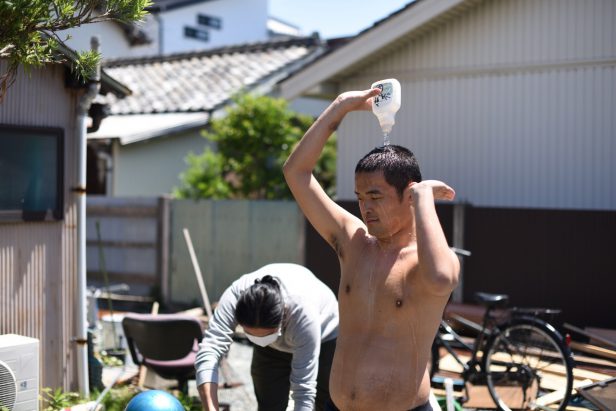
Hyōgen Miman: Less than Expression, More than Expression
Creative Support LET’S has held a number of events over the past three years that explore the concept of hyōgen miman (表現未満), translated here as “less than expression”. To give a few examples, they’ve held live music performances for clients who like singing, art exhibitions for those who like painting and the like, and myriad other events that have become ways to celebrate enjoying interesting things with interesting people. LET’S puts on hyōgen miman events in which the clients — as experts on hyōgen miman — are also the leading artists or performers. My own project here is, in fact, to archive hyōgen miman.
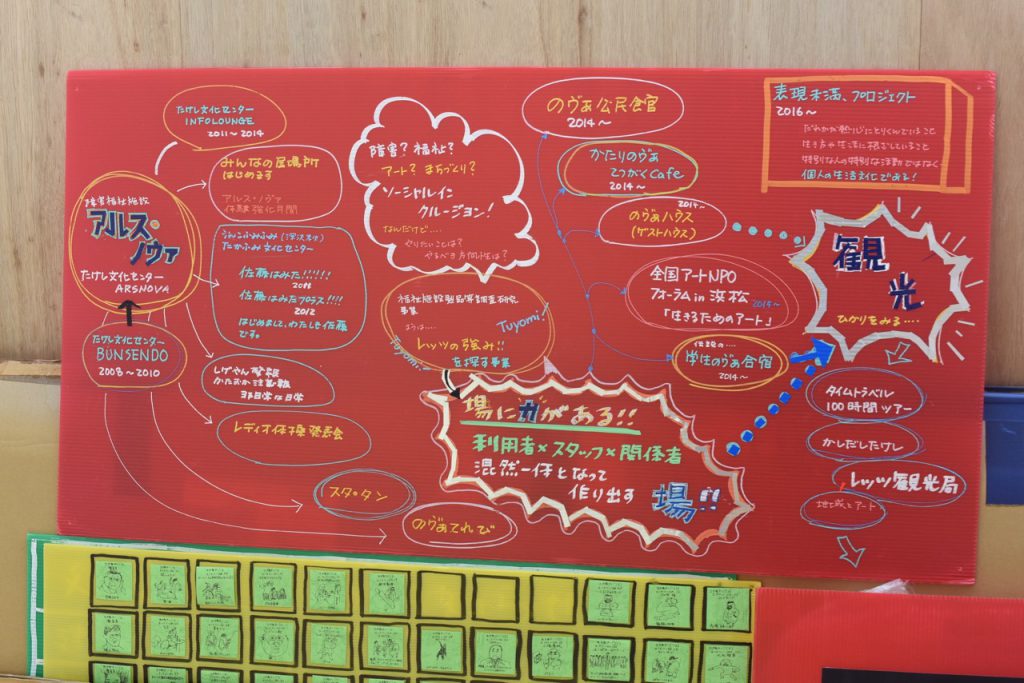
The phrase hyōgen miman (“less than expression”) may seem easy enough to understand at first glance, but it’s actually a concept that’s quite difficult to explain. It may be one of those ideas that feels easy to understand while simultaneously also being very profound.
Hyōgen miman as explained in the official brochure:
Hyōgen miman is the way each and every one of us expresses ourselves and it is the things that we personally hold dear; the things that nobody else can decide are worthless. To our way of thinking, hyōgen miman forms the very axis of creation of culture. Hyōgen miman also means accepting the existence of another person in their entirety. There are many types of people in this world and each individual has their own values. Neither people nor values can be categorized by anything as simple as “good” or “bad”: as each person respects others and is respected themselves, new values are born, and everyone thinks more about how we live together in society. These are the hopes of the hyōgen miman project.
I previously reported on art created by people with disabilities. When artists without professional artistic training create work, driven by the desire to express themselves, that work is referred to as “Art Brut” or, in Japan, “Able Art”. Back when I first covered this topic, unvarnished descriptions such as “fundamental desire” and “the urge to create for no reason” came to mind. When I learned of hyōgen miman, I intuitively thought that it might be something similar to these concepts. I might be wrong, though, as my understanding of hyōgen miman is still evolving. Nonetheless, I’ve drawn a connection between these concepts and hyōgen miman as I try to better understand the latter.
May 30th: the morning of the second day after I came to Takebun (the Takeshi Culture Center Renjakucho) operated by LET’S. While eating a hamburger at a nearby MOS Burger restaurant, I was thinking about the above paragraphs I had written on “less than expression” (hyōgen miman). Well, to be precise, what I was thinking about was actually “more than expression” (hyōgen ijō 表現以上).
More than expression. In other words, something that goes beyond a person’s basic modes of operation. An action with motive. An action that’s purpose has been determined. An action that society attaches some kind of meaning to. Things that can be converted into money or are designed to earn “like”s online. Things made for a client. These can all be considered to be “more than expression” and are how society in general defines hyōgen (“expression”).
I couldn’t help but realize how completely accustomed I am to this world of “more than expression”. My manuscript is converted into cash and, once I’ve sent it out, I want it to go viral, wishing I could get paid more for my work. In the world of “more than expression”, everything has purpose, intention, value, and is evaluated. It’s quite natural.
However, when I think about “more than expression” like this I paradoxically start wondering whether areas of “less than expression” exist as well. Feeling a bit blue, I finished the hamburger, drank every last drop of the iced coffee in which the ice had completely melted, and headed back to Takebun.
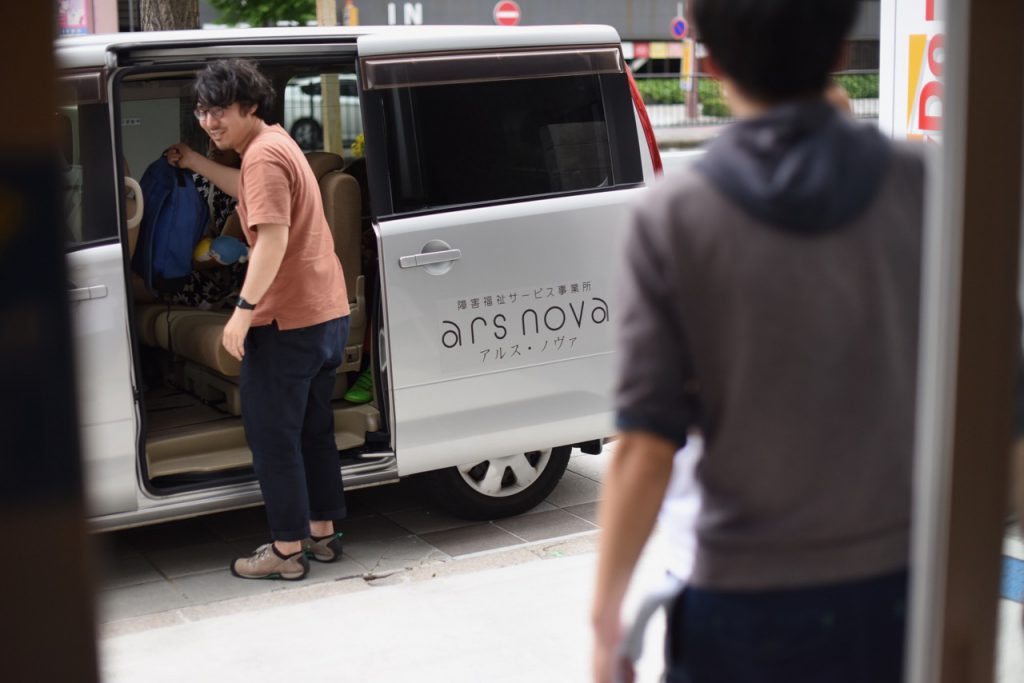
When I arrived at Takebun, some of the staff were preparing to open the center and I got in the shuttle. In addition to “Takebun”, LET’S also operates another facility called the “Nova Community Center” in Irino-cho, Hamamatsu City. LET’S says that these two sites combined accommodate a total of thirty clients. I don’t know whether that’s a lot or a little.
According to a survey conducted by the Cabinet Office, there are about 1.08 million people in Japan who are considered to have cognitive disabilities. That’s roughly nine people out of every thousand. Iwaki City, where I live, has a population of 360,000. Following that formula, that means about 3240 people with disabilities live in Iwaki. Hamamatsu City has a population of 800,000, so it follows that there are about 7200 people with disabilities living in Hamamatsu. A population that size calls for at least 200 facilities like LET’S. So how many of these facilities are there in Hamamatsu City? That’s an investigation for another time.
Heading straight to Irino from Renjaku only takes about twenty minutes by car, but picking up all the clients, either from their homes or other meeting points, takes over an hour. While we headed to Irino, I chatted with Takabayashi-san, the LET’S staff member who was driving. Takabayashi-san told me many an interesting tale, which I will cover later in another article. For now let’s move on to introducing the “Nova Community Center”.
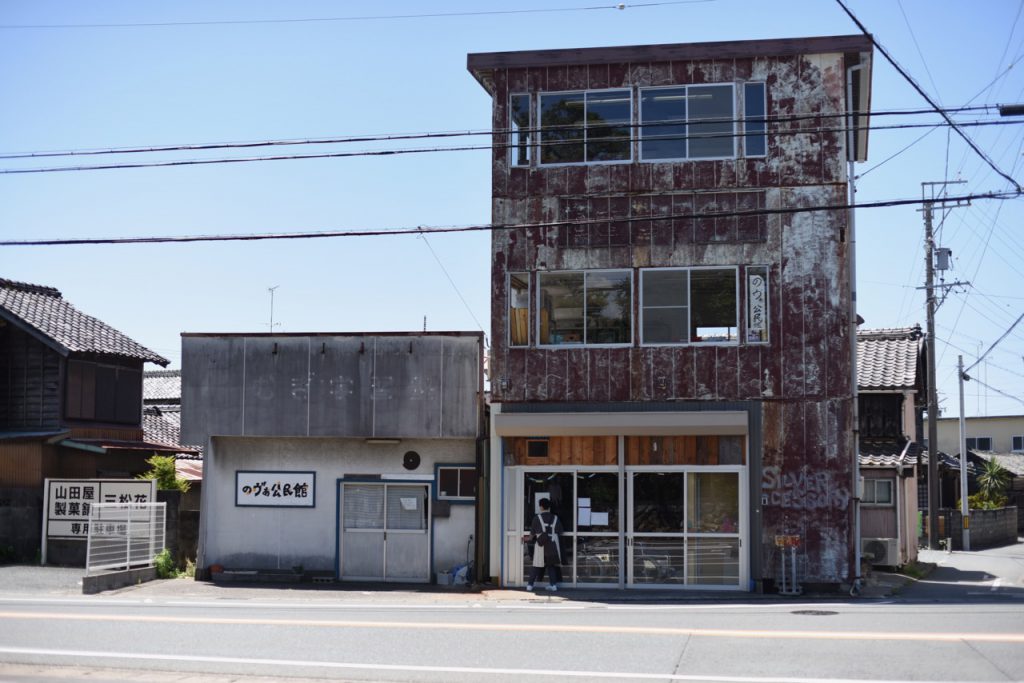

Who’s Bothered by a Bit of Bathing?
People with disabilities also come to the Nova Community Center to spend the day. The Community Center is located in Irino-cho, which is a residential area near a small lake called Lake Sanaruko. Unlike Takebun in Renjaku-cho near the station, it is very quiet at the Nova Community Center. Many of the people there were doing craftwork, drawing, and so on, or taking naps in a large room.
However, when I went around to the back of the building, something completely different was going on. Despite the fact that it certainly wasn’t summer, I found a young man with a shaved head bathing outside very comfortably.
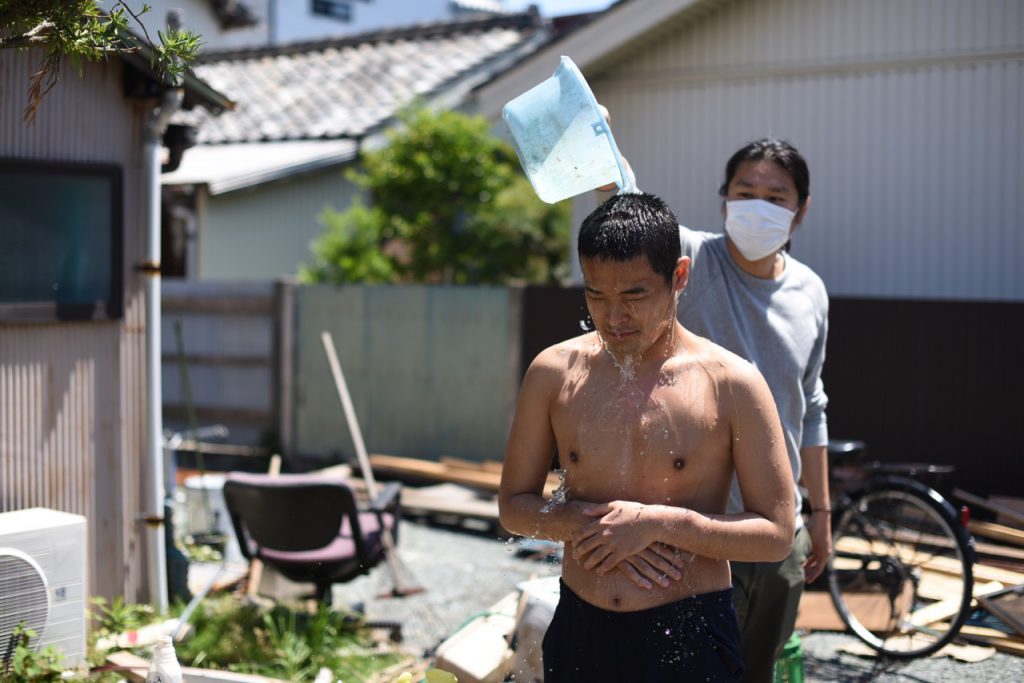
Meet Tsuchiya-kun. He loves water. Even if the staff asks him not to, he’s so attached to water that he’ll keep a water bottle hidden in his pocket, or wet his underwear. Tsuchiya-kun looked very happy, bathing there in front of me.
Well, he’s like a fish in water. “How enthusiastic he is,” remarked Fukiko-san, the female staff member beside him. “Tsuchiya-kun has a strong desire to explore getting wet.”
A strong desire to explore! If an adult bathes in a place like this, people will say, “What are you doing? You’ll catch a cold”. Some people might even get angry because they find it annoying. But, strangely, it seems very positive when I think that he bathes in order to explore. I gradually began to feel that bathing and Tsuchiya-kun are inseparable. The only thing one has to be careful of is not to catch a cold. He makes me want to bathe, too.
Contrary to my easy-going thoughts, however, there seems to have been some conflict over the matter of bathing. That afternoon, Fukiko-san told me — her words gushing forth like a torrential downpour let loose from a dam — about the various conflicts that arose among the LET’S staff members until they were able to reach the conclusion that “it’s okay to bathe”.
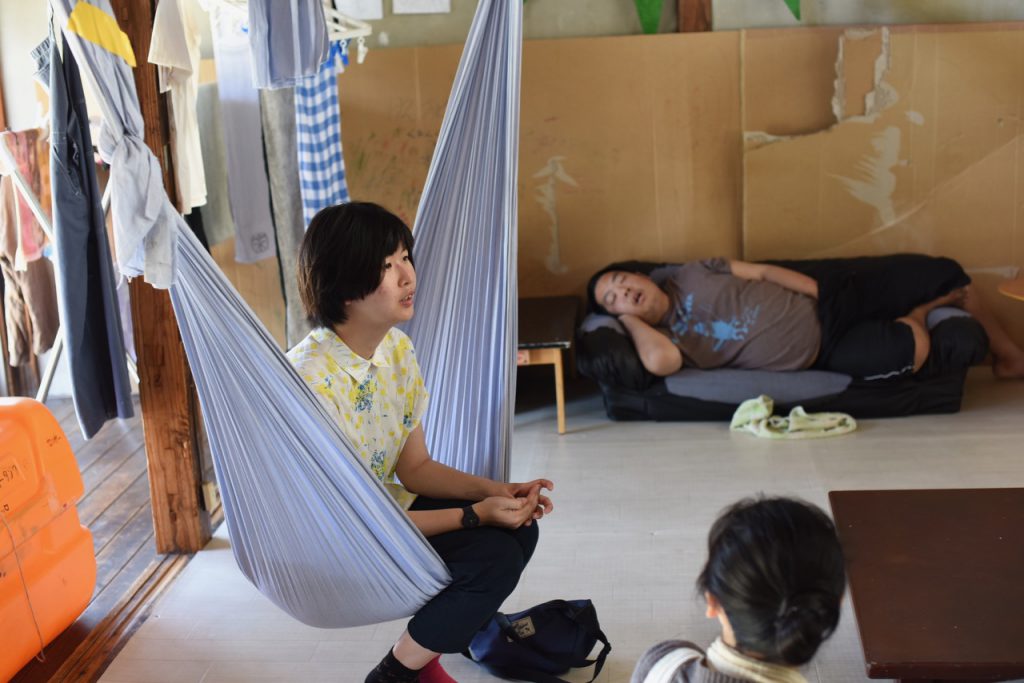
“I used to get angry and scold Tsuchiya-kun when he would pour water over his head, but I also had to wonder why this made me angry. When the staff members got together and discussed the question of who would be bothered by him bathing, Kubota-san asked, ‘You’re the one who’s bothered by it, aren’t you?’, and I realized she was right.”
“So I decided to change my perspective and create a space where he can bathe. I just worry that he could catch a cold and that there will be more laundry to do. As long as we prepare a change of clothes for him, then his bathing shouldn’t bother his mom, so that’s what we decided to do. While I understood that this was the right choice to make, it was also a difficult decision for me to swallow.”
“Agreeing with this choice might have been what really allowed me to accept Tsuchiya-kun. Tsuchiya-kun can’t go to the bathroom properly, you know. He pees himself. Then I get angry and ask him why he’s dripping wet. I’m tired. He’s tired. One time he wet just his underclothes, and another time he soaked himself using the water bottle in his pocket, and after I told him he mustn’t do that, he finally poured his bottle of juice all over his head.”
“Then I just had to laugh. Tsuchiya-kun is amazing. What a strong desire to explore. That’s when I let go and could accept my own anger. It was a real relief to know that I’m allowed to get angry. Before, I’d just feel guilty about getting angry, but the senior staff members told me that it’s natural to get angry, so I was able to begin to accept my own feelings.”
“I may be his support, but I’m only human. If I’m not feeling up to it or not doing well, then I’m allowed to ask other staff members to take my place. I think knowing that really helped me start to accept both myself and Tsuchiya-kun.”
Fukiko-san had felt she was stuck with supporting Tsuchiya-kun. When she was released from that feeling of being trapped, Tsuchiya-kun was also able to be himself. It’s not impossible to interpret this series of events in this way, is it?
For some reason, Fukiko-san’s honest story struck a chord with me. Perhaps because I had a similar conflict with my own daughter, though this conflict was on a much smaller scale.

Is Hyōgen Miman Like a Pair of Glasses?
I think again of my four-year-old daughter. She always tells me that she wants to wear a skirt every morning when we get her dressed. She doesn’t listen when I ask her to wear pants since she’ll be playing outside. When we take her to kindergarten, we bring a skirt with us because she begs us, saying “I’ll wear pants tomorrow, so please let me wear a skirt today”, but the next day she starts crying about having to wear pants again. Every day this cycle is repeated, even on busy mornings, and the number of skirts in her dresser just goes on multiplying.
When skirts get dirty it means more work for us parents. Looking at it that way, we may just want her to wear pants for our own convenience. She doesn’t care if she gets dirty or if mosquitoes bite her. But, on the other hand, as parents we’re supposed to “discipline” her so she’ll play without getting her clothes dirty. I worry that accepting her demands will spoil her or make her selfish.
One morning, this whole thing started up again when I was really busy, and I forced my crying daughter to put on her pants. How did she feel, the rest of that day? Was it a bad day? Or maybe she found that wearing pants wasn’t so bad, after all.
That’s when I noticed something.
She wants to wear skirts no matter what. She’s absolutely obsessed with skirts. Isn’t this something like hyōgen miman?
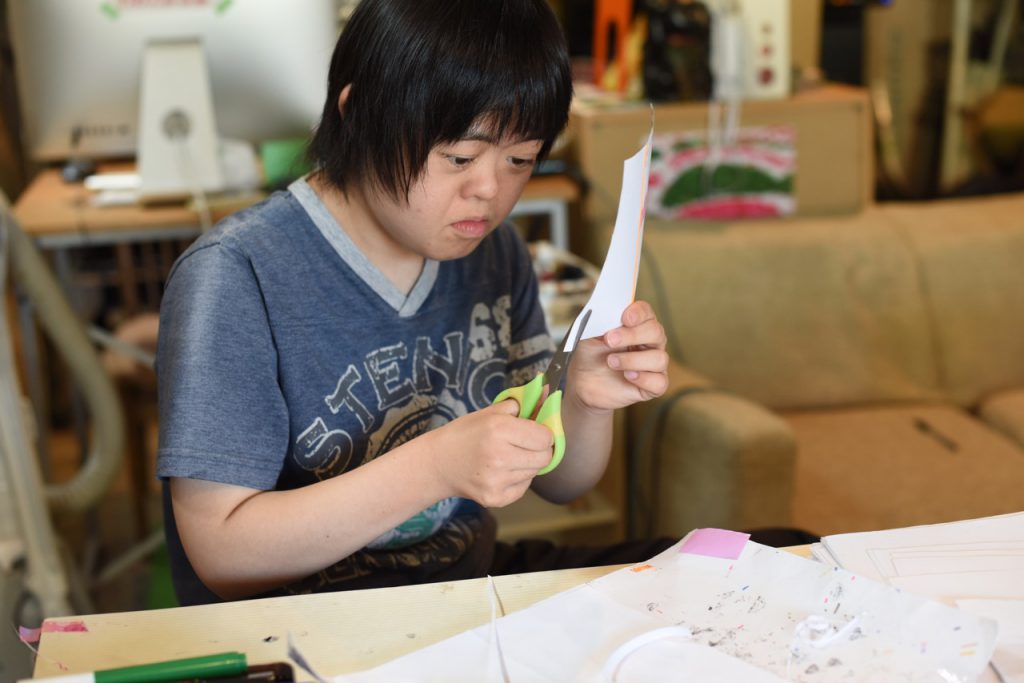
Something done without reason, meaning, or calculation. Something a person is obsessed with. For my daughter, I thought, that might mean skirts. That simply means my daughter is a girl who only wants to wear skirts. Her wanting to wear skirts makes her “herself”, not “selfish”.
I don’t know whether this is the correct way to interpret hyōgen miman. Maybe I’ve just interpreted it this way for my own convenience. Whether it’s correct or not, though, I thought that Tsuchiya-kun’s bathing and my daughter’s fascination with skirts are not so different. Tsuchiya-kun’s happy face and my daughter’s cheerful smile when she puts on a skirt overlapped in my mind’s eye.
By extension of this logic, my wife, my father, my mother, and myself — we all possess the power of hyōgen miman, don’t we? We who live in a world inundated with “more than expression” have never tried to see or feel hyōgen miman, but it is by no means limited to those with disabilities.
Here’s how I think of it. Hyōgen miman may be like putting on a pair of glasses. Once you’re wearing those glasses, things which you previously considered to be a “nuisance” in the world of “more than expression” are now permissible for some reason. Bit by bit each person’s “individuality” emerges from the morass of social values, intentions, objectives, and results. It’s like how Fukiko-san was describing Tsuchiya-kun’s bathing as a strong desire to explore. These glasses enable us to see how unique each person is.
I may not be able to see perfectly clearly through these glasses just yet. But I feel like I could wear them. For now, that is enough. This is only the second day, after all. I’ve got a long way to go yet. I hope I can go on enjoying these glasses, and that I can find out how to wear them better as I keep on coming to LET’S.
Translator : Koya sato, Anna schnell
コメント
この記事へのトラックバックはありません。


-50x50.jpg)




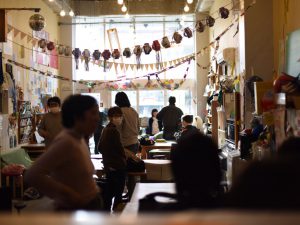
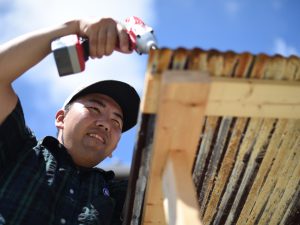
この記事へのコメントはありません。